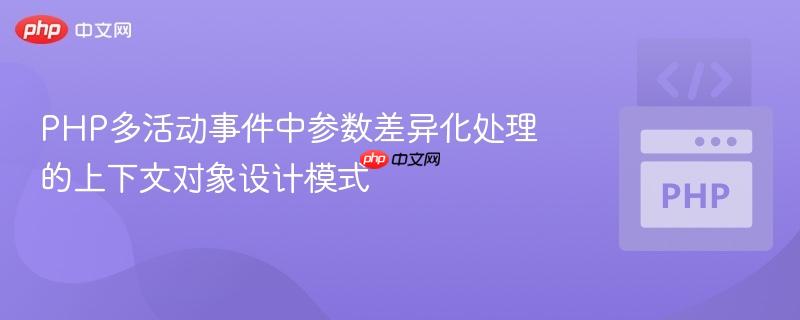
在php中,当多个活动或模块需要响应同名事件,但这些事件的参数列表却各不相同时,传统的接口定义会面临挑战。本文将介绍如何运用上下文对象设计模式,通过为每个事件类型创建特定的上下文接口和实现类,来封装事件的动态参数,从而在保持接口统一性的同时,实现事件参数的灵活管理和类型安全。
在复杂的应用中,我们经常会遇到这样的场景:存在多个独立的业务模块(例如不同的营销活动Campaigns),它们需要对同一类型的事件(如“首次购买”、“首次交易”)做出响应。然而,尽管事件名称相同,但不同活动对这些事件的关注点和所需的参数却可能大相径庭。
例如,我们有FirstCampaign、SecondCampaign和ThirdCampaign三个活动类,它们都包含onFirstPurchase和onFirstTrade这两个事件处理方法。问题在于,这些方法的参数签名在每个活动类中都不同:
class FirstCampaign {
public function onFirstPurchase($arg1, $arg2, User $user) {
// ...
}
public function onFirstTrade($price, $something, User $user, Model $model) {
// ...
}
}
class SecondCampaign {
public function onFirstPurchase(User $user) {
// ...
}
public function onFirstTrade(Model $model) {
// ...
}
}
class ThirdCampaign {
public function onFirstPurchase(User $user, Model $model, int $abc) {
// ...
}
public function onFirstTrade() {
// ...
}
}在这种情况下,如果尝试使用传统的PHP接口来统一这些活动类的行为,我们会立即遇到障碍。接口要求所有实现类的方法签名必须完全一致,这与我们参数差异化的需求相悖。虽然PHP支持可变参数(...$arguments),但这种方式牺牲了类型安全,并且在处理大量或复杂参数时,代码的可读性和可维护性会急剧下降。
为了优雅地解决上述问题,我们可以引入“上下文对象(Context Object)”设计模式。其核心思想是:将事件处理方法中那些动态变化的、事件特有的参数封装到一个专用的上下文对象中。这样,事件方法的接口签名就可以保持固定,只接受通用实体(如User)和这个事件特定的上下文接口。
立即学习“PHP免费学习笔记(深入)”;
首先,我们为所有活动定义一个通用的接口CampaignInterface,它包含了所有活动都应响应的事件方法。这些方法的参数将包括任何通用且不变的实体(如User),以及一个代表事件特定参数的上下文接口。
<?php
interface CampaignInterface {
public function onFirstPurchase(User $user, PurchaseContextInterface $context);
public function onFirstTrade(TradeContextInterface $context);
}接着,为每种事件类型定义一个独立的上下文接口。这些接口本身可以为空,或者定义一些所有上下文对象都应具备的通用方法(如果存在)。它们的主要作用是作为类型提示,确保传入的是正确的上下文对象。
<?php
// 用户类,假设已存在
class User {}
// 模型类,假设已存在
class Model {}
interface PurchaseContextInterface {
// 可以定义通用方法,或保持为空作为标记接口
}
interface TradeContextInterface {
// 可以定义通用方法,或保持为空作为标记接口
}现在,每个具体的活动类(如FirstCampaign)都将实现CampaignInterface。在实现事件方法时,它将接收一个User对象和一个具体的上下文对象。这个上下文对象将由该活动类自行定义和实现,以封装其所需的所有特定参数。
<?php
// 具体的活动类实现
class FirstCampaign implements CampaignInterface {
public function onFirstPurchase(User $user, PurchaseContextInterface $context) {
// 确保传入的是FirstCampaignPurchaseContext
if ($context instanceof FirstCampaignPurchaseContext) {
echo "FirstCampaign: onFirstPurchase for User ID: " . $user->getId() . "\n";
echo "Arg1: " . $context->getArg1() . ", Arg2: " . $context->getArg2() . "\n";
} else {
throw new InvalidArgumentException("Invalid context for FirstCampaign::onFirstPurchase");
}
// ... 具体的业务逻辑
}
public function onFirstTrade(TradeContextInterface $context) {
if ($context instanceof FirstCampaignTradeContext) {
echo "FirstCampaign: onFirstTrade\n";
echo "Price: " . $context->getPrice() . ", Something: " . $context->getSomething() . "\n";
// ... 具体的业务逻辑
} else {
throw new InvalidArgumentException("Invalid context for FirstCampaign::onFirstTrade");
}
}
}最后,为每个活动类和每种事件类型创建具体的上下文实现类。这些类将实现对应的上下文接口,并包含该事件在该活动中所需的所有参数,通常通过构造函数注入和公共的getter方法提供。
<?php
// FirstCampaign 专属的购买事件上下文
class FirstCampaignPurchaseContext implements PurchaseContextInterface {
private $arg1;
private $arg2;
public function __construct($arg1, $arg2) {
$this->arg1 = $arg1;
$this->arg2 = $arg2;
}
public function getArg1() {
return $this->arg1;
}
public function getArg2() {
return $this->arg2;
}
}
// FirstCampaign 专属的交易事件上下文
class FirstCampaignTradeContext implements TradeContextInterface {
private $price;
private $something;
private $model; // 假设Model是通用类型
public function __construct($price, $something, Model $model) {
$this->price = $price;
$this->something = $something;
$this->model = $model;
}
public function getPrice() {
return $this->price;
}
public function getSomething() {
return $this->something;
}
public function getModel(): Model {
return $this->model;
}
}
// 示例:SecondCampaign 的上下文
class SecondCampaignPurchaseContext implements PurchaseContextInterface {
// SecondCampaign::onFirstPurchase 只需要User,所以这个上下文可以为空或者只包含特定于SecondCampaign的额外信息
public function __construct() {}
}
class SecondCampaignTradeContext implements TradeContextInterface {
private $model;
public function __construct(Model $model) {
$this->model = $model;
}
public function getModel(): Model {
return $this->model;
}
}当在应用程序的不同部分触发事件时,你需要根据当前活动的类型和事件所需的参数,创建相应的上下文对象并传递给事件方法:
<?php
// 假设我们有一个用户对象和一个模型对象
$currentUser = new User();
$currentModel = new Model();
// 实例化 FirstCampaign
$firstCampaign = new FirstCampaign();
// 触发 FirstCampaign 的 onFirstPurchase 事件
$purchaseContextForFirstCampaign = new FirstCampaignPurchaseContext('valueA', 'valueB');
$firstCampaign->onFirstPurchase($currentUser, $purchaseContextForFirstCampaign);
// 触发 FirstCampaign 的 onFirstTrade 事件
$tradeContextForFirstCampaign = new FirstCampaignTradeContext(100.50, 'product_id_xyz', $currentModel);
$firstCampaign->onFirstTrade($tradeContextForFirstCampaign);
// 实例化 SecondCampaign
$secondCampaign = new SecondCampaign();
// 触发 SecondCampaign 的 onFirstPurchase 事件
$purchaseContextForSecondCampaign = new SecondCampaignPurchaseContext(); // 此时上下文可能为空或包含少量信息
$secondCampaign->onFirstPurchase($currentUser, $purchaseContextForSecondCampaign);
// 触发 SecondCampaign 的 onFirstTrade 事件
$tradeContextForSecondCampaign = new SecondCampaignTradeContext($currentModel);
$secondCampaign->onFirstTrade($tradeContextForSecondCampaign);上下文对象设计模式为处理多活动事件中参数差异化的问题提供了一个优雅而健壮的解决方案。通过将事件的动态参数封装到专用的上下文对象中,我们可以在保持接口统一性、确保类型安全的同时,实现事件参数的灵活管理和高度可扩展性。这种模式在构建大型、可维护且易于扩展的PHP应用中具有重要的实践价值。
以上就是PHP多活动事件中参数差异化处理的上下文对象设计模式的详细内容,更多请关注php中文网其它相关文章!

PHP怎么学习?PHP怎么入门?PHP在哪学?PHP怎么学才快?不用担心,这里为大家提供了PHP速学教程(入门到精通),有需要的小伙伴保存下载就能学习啦!

Copyright 2014-2025 https://www.php.cn/ All Rights Reserved | php.cn | 湘ICP备2023035733号